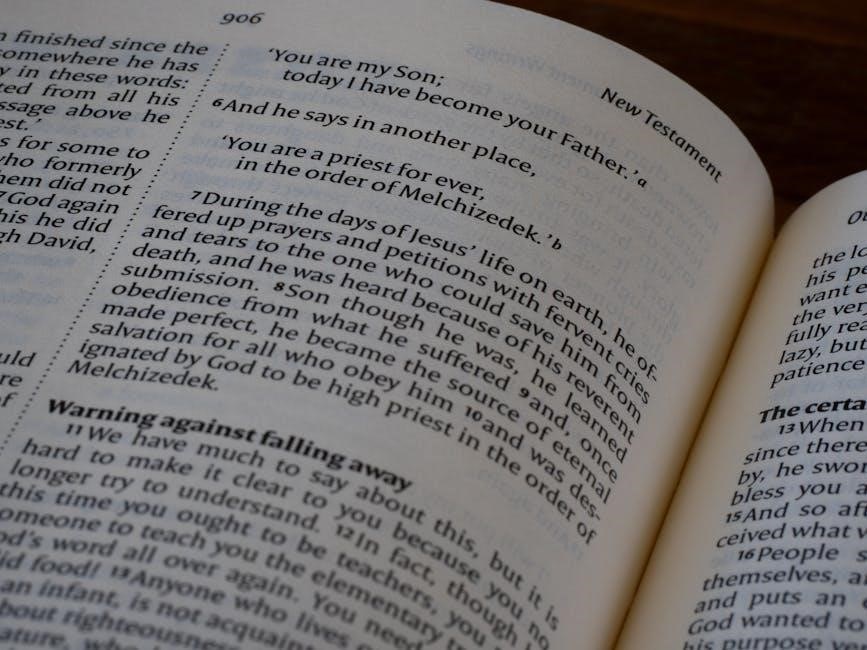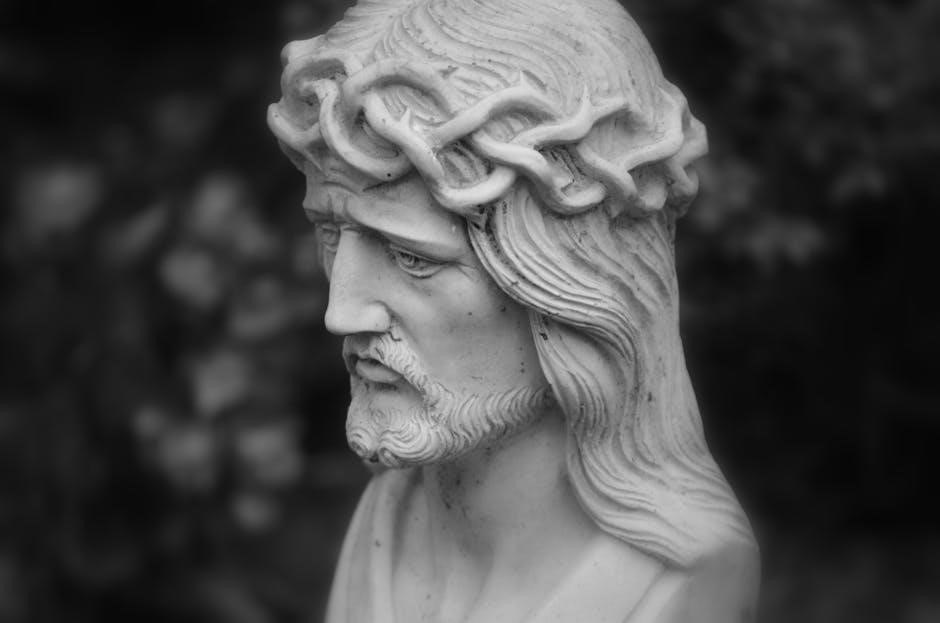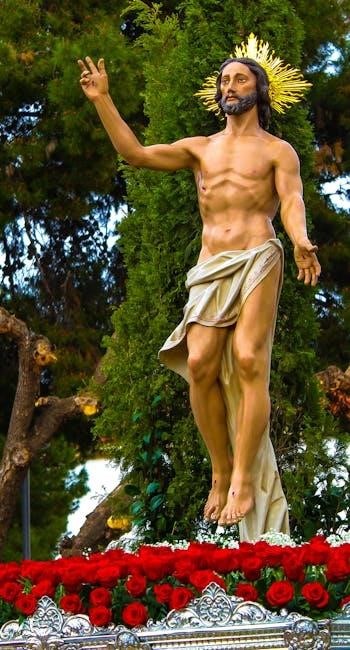
Handel’s Messiah is a monumental sacred oratorio composed in 1741, blending orchestral and choral brilliance. Its PDF score is widely available for study and performance, showcasing its enduring legacy.
1.1 Historical Context of Messiah
Composed by George Frideric Handel in 1741, Messiah emerged during a period of significant cultural and religious transformation in Europe. The oratorio was written in just 24 days, reflecting Handel’s creative intensity. Its premiere in Dublin in 1742 marked a pivotal moment in musical history, with proceeds benefiting local charities. The work draws heavily from biblical texts, particularly Isaiah and the Psalms, emphasizing themes of redemption and divine prophecy. The PDF score reveals intricate orchestration and choral arrangements, showcasing Handel’s mastery of Baroque music. Messiah quickly gained acclaim, becoming a cornerstone of sacred music and a testament to Handel’s enduring legacy.
1.2 Significance of Messiah in Classical Music
Messiah holds a preeminent place in classical music as a cornerstone of sacred oratorio. Its innovative use of choral and orchestral elements revolutionized the genre, influencing countless composers. The PDF score highlights Handel’s masterful integration of biblical texts with musical motifs, creating a work of profound emotional depth. Messiah is celebrated for its universal themes, transcending denominational boundaries. Its iconic movements, such as the “Hallelujah Chorus,” have become synonymous with classical music itself. The oratorio’s enduring popularity underscores its significance as both a religious and cultural touchstone, ensuring its continued relevance in modern performances and studies. The availability of the Messiah PDF score has further cemented its status as an indispensable resource for musicians and scholars alike.

Composition and Structure of Messiah
Composed in just 24 days, Messiah is structured as a sacred oratorio in three parts, reflecting the life of Christ. Its PDF score reveals Handel’s masterful orchestration and choral design.
2.1 The Libretto and Its Sources
The libretto of Messiah was crafted by Charles Jennens, drawing heavily from the King James Bible. It combines passages from Isaiah, Psalms, and Revelation, with a focus on the life of Christ. The text is divided into three parts: the prophecy and birth of the Messiah, the Passion, and the resurrection. Jennens’ work provided a theological framework that Handel transformed into a musical masterpiece. The PDF score includes the full libretto, allowing performers and scholars to study the textual and musical interplay. This structure ensures the oratorio’s narrative coherence, making it a cornerstone of sacred music.
2.2 The Three Parts of Messiah
Handel’s Messiah is structured into three distinct parts, each serving a theological and narrative purpose. Part I focuses on the prophecy and birth of the Messiah, drawing from Isaiah and other biblical texts. Part II recounts the Passion of Christ, emphasizing His death and resurrection. Part III celebrates the triumph of Christ and the redemption of humanity. This tripartite structure provides a cohesive narrative, guiding listeners through the divine plan of salvation. The PDF score reflects this division, offering a clear framework for performers and scholars to explore the oratorio’s dramatic and spiritual depth.
2.3 Key Musical Themes and Motifs
Handel’s Messiah is renowned for its rich and recurring musical themes, which underscore the oratorio’s theological narrative. The opening Sinfony sets a majestic tone, while the “Comfort Ye” aria introduces a soothing melody that recurs throughout. The “Hallelujah Chorus” features triumphant brass fanfares and layered choral harmonies, symbolizing divine glory. Motifs of light and redemption are woven into the score, such as the ascending arpeggios in “Every Valley Shall Be Exalted,” representing spiritual uplift. The orchestration, including strings and continuo, reinforces these themes, creating a cohesive emotional journey. These musical elements, evident in the PDF score, highlight Handel’s mastery of thematic development and his ability to convey profound spiritual messages through music.

Musical Elements of Messiah
Handel’s Messiah showcases rich orchestration, intricate choral arrangements, and expressive vocal solos. The harpsichord and organ provide harmonic foundation, while strings and brass add dramatic flair, as seen in the PDF score.
3.1 Orchestration and Instrumentation
Handel’s Messiah features a rich and balanced orchestration, with strings, woodwinds, brass, and keyboards. The PDF score reveals intricate details, such as the use of violins, violas, cellos, and double basses for harmonic depth. Woodwinds, including flutes, oboes, and bassoons, add texture and emotional nuance. Brass instruments like trumpets and trombones emphasize dramatic moments, while timpani provide rhythmic intensity. The harpsichord and organ are central to the continuo, supporting the choral and solo passages. This instrumentation creates a dynamic interplay, enhancing the oratorio’s emotional impact; The PDF score allows musicians to explore these elements, ensuring accurate performances that honor Handel’s original vision.
3.2 Choral and Vocal Arrangements
The choral and vocal arrangements in Handel’s Messiah are renowned for their complexity and beauty. The PDF score highlights the oratorio’s structure, featuring four solo voices (soprano, alto, tenor, bass) and a chorus. The chorus often represents divine or collective voices, while soloists portray individual narratives. The score’s detailed notation showcases Handel’s mastery of counterpoint, with intricate harmonies and fugues. Vocal parts are both expressive and technically demanding, requiring precise articulation and emotional depth. The PDF format allows singers and conductors to study and perform these arrangements accurately, preserving the work’s historical authenticity and artistic brilliance. This ensures that Messiah remains a cornerstone of classical choral repertoire.
3.3 The Role of the Harpsichord and Organ
The harpsichord and organ play pivotal roles in Handel’s Messiah, providing harmonic foundation and rhythmic stability. In the PDF score, the harpsichord is featured as a continuo instrument, accompanying recitativos and arias with intricate basso continuo lines. The organ, often used sparingly, enhances key moments with its rich timbre, particularly in choruses like the “Hallelujah Chorus.” Both instruments support the orchestra and voices, ensuring cohesion and depth. The PDF format captures these parts in detail, allowing modern performers to interpret Handel’s intent accurately. These keyboard instruments are essential to the oratorio’s Baroque character, showcasing Handel’s mastery of texture and instrumentation; Their roles remain vital in preserving the work’s historical and musical integrity.

Notable Arias and Choruses
Handel’s Messiah features iconic arias and choruses, including “Comfort Ye,” “Every Valley,” and the celebrated “Hallelujah Chorus,” all showcasing his masterful composition and emotional depth.
4.1 “Comfort Ye, Comfort Ye My People”
“Comfort Ye, Comfort Ye My People” is the opening aria from Handel’s Messiah, sung by a tenor. It sets the tone for redemption, drawing from Isaiah 40:1-5. The aria is an accompagnato, featuring orchestral accompaniment that underscores its emotional depth. This piece transitions into “Every Valley Shall Be Exalted,” showcasing Handel’s seamless storytelling. Its melody, both comforting and powerful, reflects the prophetic message of hope. The PDF score highlights Handel’s intricate orchestration, making it a vital resource for musicians and scholars. This aria remains a cornerstone of Messiah, embodying its spiritual and musical essence.
4.2 “Every Valley Shall Be Exalted”
“Every Valley Shall Be Exalted” is a celebrated tenor aria from Handel’s Messiah, based on Isaiah 40:4. Its soaring melody and intricate runs highlight the prophet’s vision of a leveled landscape, symbolizing equality and divine justice. The aria transitions seamlessly into the chorus “And the Glory of the Lord,” emphasizing its central role in the oratorio’s narrative. The PDF score provides detailed insights into the aria’s structure, showcasing Handel’s mastery of vocal and orchestral balance. This piece remains a cornerstone of classical vocal repertoire, with its challenging technical demands and profound emotional resonance. Performers and scholars alike rely on the PDF score to explore its nuances and historical significance.
4.3 “Hallelujah Chorus”
The “Hallelujah Chorus” is the iconic conclusion to Part II of Handel’s Messiah, renowned for its majestic orchestration and triumphant choral harmonies. This chorus, drawn from Revelation 19:6, 11:15, and 19:16, proclaims Christ’s eternal reign. The PDF score reveals intricate details of its layered structure, showcasing Handel’s compositional genius. Performances often feature standing audiences as a sign of respect. Its enduring popularity is evident in countless renditions and its presence in the Messiah PDF, which facilitates study and performance. This chorus remains a pinnacle of classical music, symbolizing hope and joy for generations. Its availability in digital formats ensures its continued relevance and accessibility for modern audiences and scholars alike.

Historical Performances of Messiah
Handel’s Messiah premiered in Dublin in 1742, followed by its London debut in 1743. These performances established its sacred status, with the PDF score aiding modern renditions.
5.1 The Premiere in Dublin (1742)
The premiere of Handel’s Messiah took place in Dublin on April 13, 1742, at the New Music Hall. This historic performance was a charity event, raising funds for local hospitals and debtors. The oratorio was performed by a large choir and orchestra, showcasing Handel’s mastery of choral and orchestral arrangements. The event was a resounding success, with the audience moved by the powerful music and spiritual themes. The PDF score of Messiah has preserved this version, allowing modern musicians to study and perform it faithfully. Handel’s innovative use of orchestration and choral techniques set a new standard for sacred music, cementing Messiah as a timeless classic. Its debut in Dublin remains a pivotal moment in music history.
5.2 The First Performance in London
Handel’s Messiah received its London premiere on March 23, 1743, at the Theatre Royal, Covent Garden. The performance was met with enthusiasm, though initial reception was mixed due to its sacred nature being presented in a secular venue. The concert featured a large choir and orchestra, further showcasing Handel’s orchestration skills. The PDF score of Messiah highlights the version performed in London, which included slight modifications from the Dublin premiere. This event marked the beginning of the work’s widespread popularity in England, solidifying its place in classical music history. The London premiere demonstrated Handel’s ability to adapt his work for different audiences while maintaining its spiritual core and artistic brilliance.
5.3 Notable Modern Performances
Modern performances of Handel’s Messiah continue to captivate audiences worldwide. One notable rendition was the 2022 concert by the London Symphony Orchestra at the Barbican Centre, featuring a digital projection of the Messiah PDF score, enhancing audience engagement. Another highlight was the 2019 performance at New York’s Carnegie Hall, blending traditional and contemporary interpretations. These performances often utilize the widely available PDF scores, allowing choirs and orchestras to study and perform the work with precision. The integration of digital formats has made Messiah accessible to a broader audience, ensuring its timeless appeal endures. These modern interpretations honor Handel’s legacy while introducing the masterpiece to new generations through innovative presentations and technologies.

Cultural and Religious Impact
Handel’s Messiah bridges classical music and sacred traditions, inspiring devotion and artistic admiration worldwide. Its themes of redemption resonate deeply, making it a cultural and religious cornerstone.
6.1 Messiah as a Sacred Oratorio
Handel’s Messiah stands as a pinnacle of sacred oratorio, blending biblical texts with sublime music. Composed in 1741, it captures the essence of Christian theology through its libretto, derived from the King James Bible and the Book of Common Prayer. The oratorio’s structure, divided into three parts, reflects the narrative of Christ’s birth, death, and resurrection. Its sacred themes are conveyed through powerful choral and orchestral arrangements, creating a deeply spiritual experience. The work’s ability to inspire devotion and artistic admiration has cemented its status as a cornerstone of sacred music, transcending mere performance to become a worshipful expression of faith and redemption.
6;2 The Work’s Religious Significance
Handel’s Messiah holds profound religious significance, serving as a musical testament to Christian theology. Its libretto, drawn from biblical texts, narrates the prophecy, birth, crucifixion, and resurrection of Jesus Christ. The oratorio’s themes of redemption and divine grace resonate deeply with audiences, making it a revered work in sacred music. Composed in 1741, Messiah has become a cornerstone of religious expression, often performed during liturgical seasons like Lent and Easter. Its ability to evoke spiritual reflection and communal worship underscores its enduring role in religious traditions, transcending cultural and temporal boundaries to inspire faith and devotion across generations.
6.3 Messiah in Popular Culture
Handel’s Messiah has transcended classical music, becoming a staple in popular culture. Its iconic “Hallelujah Chorus” is frequently featured in films, TV shows, and commercials, evoking grandeur and celebration. The oratorio’s music has also been adapted in various genres, from rock to hip-hop, showcasing its versatility. Additionally, Messiah is often performed at sports events and political gatherings, further cementing its cultural impact. The availability of the Messiah PDF score has made it accessible for modern adaptations, ensuring its relevance in contemporary media. This widespread use highlights the enduring appeal of Handel’s masterpiece, bridging classical and popular traditions while maintaining its emotional and spiritual resonance.

The Messiah PDF Score
The Messiah PDF score is widely available, offering detailed orchestration and vocal arrangements. Composed in 1741, it remains a cornerstone for performances and study, ensuring accessibility for modern musicians.
7.1 Availability of the Messiah PDF
The Messiah PDF score is widely accessible due to its status as a public domain work. It can be freely downloaded from various online repositories, such as the International Music Score Library Project (IMSLP) and Choral Public Domain Library (CPDL). Many educational institutions and classical music websites also provide the score for academic and performance purposes. Additionally, platforms like Google Scholar and archive.org host digitized versions of the score, ensuring its availability for musicians, researchers, and enthusiasts worldwide. This ease of access has facilitated its study and performance across generations, making Handel’s masterpiece a cornerstone of classical music education and appreciation.

7.2 Uses of the PDF Score
The PDF score of Messiah serves multiple purposes, primarily as a resource for musicians and scholars. Conductors and performers use it to study and rehearse, while musicologists analyze its composition and historical significance. Educators incorporate the score into curricula for teaching orchestration, choral techniques, and Baroque music styles. Additionally, the PDF is utilized by audiences to follow performances, enhancing their appreciation of the work. It is also a valuable tool for arrangers and composers seeking inspiration from Handel’s mastery. The accessibility of the PDF ensures that Messiah remains a vibrant and relevant work in modern musical education and practice, bridging the past with contemporary learning and performance.
7.3 Legal and Copyright Considerations
Handel’s Messiah is in the public domain, but specific PDF scores may be copyrighted. Modern editions, arrangements, or annotated versions often remain under copyright. Users must respect these rights, ensuring permission is obtained for commercial use. Free public domain scores are widely available, but verifying the source is essential. Copyright laws vary globally, so checking local regulations is advisable. Academic or non-profit use may qualify as fair use in some regions. Always prioritize legal compliance when accessing or sharing the Messiah PDF to avoid infringement issues.

Educational Resources and Guides
Educational resources for Messiah include study guides, score analyses, and workshops, providing in-depth insights for students and musicians to explore Handel’s masterpiece effectively.
8;1 Study Guides for Messiah
Study guides for Handel’s Messiah provide comprehensive insights into its composition, historical context, and musical structure. These resources often include detailed commentary on the libretto, analysis of key arias and choruses, and explanations of theological themes. Many guides are available in PDF format, offering accessibility for both students and scholars. They frequently incorporate historical background, such as the premiere in Dublin and its reception, as well as insights into Handel’s creative process. Some guides also explore the cultural and religious significance of the oratorio, making them invaluable for educational purposes. Additionally, they may include exercises or quizzes to enhance understanding, helping learners engage deeply with the masterpiece.
8.2 Analyzing the Score
Analyzing the score of Handel’s Messiah reveals its intricate composition and thematic depth. The PDF score provides a detailed layout of orchestration, vocal arrangements, and harmonic structures. It highlights the oratorio’s three-part structure, each reflecting different biblical themes. The score showcases key movements, such as the iconic “Hallelujah Chorus” and the haunting “Pifa” (Pastoral Symphony). Analyzing the score allows musicians and scholars to explore Handel’s use of motifs, choral counterpoint, and instrumental textures. Resources like annotated PDFs and musical guides offer insights into historical performance practices and interpretive nuances. These tools are essential for understanding the work’s complexity and its enduring influence on classical music. They also aid in preparing for performances, making the score a vital resource for both study and execution.
8.3 Educational Performances and Workshops
Educational performances and workshops centered on Handel’s Messiah provide unique opportunities for students and musicians to engage with the oratorio. These events often involve guided rehearsals, lectures, and interactive sessions, utilizing the PDF score to explore its musical and historical significance. Workshops may focus on specific sections, such as the “Hallelujah Chorus” or “Comfort Ye,” allowing participants to delve into vocal techniques, orchestration, and interpretive nuances. These programs are designed to foster a deeper understanding and appreciation of the work, making it accessible to both young musicians and audiences. They also encourage collaboration, creativity, and skill development, ensuring the legacy of Messiah continues to inspire future generations.

The Legacy of Handel’s Messiah
Handel’s Messiah remains a cornerstone of classical music, with its PDF score widely used in performances and education. Its influence spans over centuries, appearing in films, commercials, and inspiring countless arrangements. This enduring popularity ensures Messiah’s continued relevance and appreciation across diverse audiences, solidifying its legacy as a timeless masterpiece.
9.1 Influence on Later Composers
Handel’s Messiah has profoundly influenced classical music, inspiring composers like Mozart, Beethoven, and Mendelssohn. Its grand choral movements and orchestral richness set a benchmark for sacred music. Mozart rearranged Messiah, showcasing its timeless appeal. The oratorio’s innovative use of libretto from scripture and its dramatic structure have been emulated in later works. Modern composers continue to draw inspiration from its thematic depth and emotional resonance. The availability of the Messiah PDF score has further facilitated study and adaptation, ensuring its legacy endures in contemporary compositions across diverse genres.
9.2 Enduring Popularity of the Work
Handel’s Messiah remains a cornerstone of classical music, celebrated for its universal themes and emotional depth. Its iconic choruses, such as the “Hallelujah Chorus,” are instantly recognizable, transcending cultural boundaries. The oratorio’s adaptability to various performance settings, from grand concerts to intimate gatherings, contributes to its enduring appeal. The availability of the Messiah PDF score has democratized access, enabling performers and enthusiasts worldwide to engage with the work. Its annual performances during holidays like Easter and Christmas are a testament to its timeless relevance. This cherished masterpiece continues to inspire audiences, solidifying its place as one of the most beloved works in classical repertoire.
9.3 Messiah in the Digital Age
The digital revolution has transformed how Handel’s Messiah is accessed and experienced. PDF scores of the oratorio are widely available online, enabling musicians and scholars to study and perform the work with ease. Digital platforms offer high-quality recordings, allowing global audiences to enjoy Messiah from the comfort of their homes. Interactive tools and apps now provide deeper insights into its composition and historical context. Virtual choirs and online collaborations have emerged, fostering a new wave of engagement. This digital accessibility ensures that Messiah remains relevant and vibrant, bridging centuries of tradition with modern innovation, and inspiring future generations to embrace this timeless masterpiece.